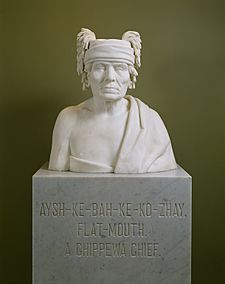Aysh-ke-bah-ke-ko-zhay facts for kids
Quick facts for kids
Aysh-ke-bah-ke-ko-zhay
|
|
|---|---|

Marble bust of Aysh-ke-bah-ke-ko-zhay in the US Senate by Francis Vincenti
|
|
| Ojibwa leader | |
| Personal details | |
| Children | Niganibines |
| Known for | Negotiated cession of ten million acres, including the headwaters of the Mississippi |
| Nickname | "Flat Mouth" (Gueule Platte) |
Aysh-ke-bah-ke-ko-zhay (also known as Aish-Ke-Vo-Go-Zhe) was a respected and powerful Ojibwe chief. His name, Eshkibagikoonzhe, means "[bird] having a leaf-green bill" in the Anishinaabe language. He was also called "Flat Mouth" (Gueule Platte) by French fur traders. In 1855, Chief Aysh-ke-bah-ke-ko-zhay traveled to Washington, D.C. with other Ojibwe leaders, including Beshekee. Their important mission was to negotiate a treaty. This treaty involved giving up a huge area of land, about ten million acres (40,000 square kilometers). This land included the very start of the Mississippi River in northern Minnesota.
Contents
Who Was Chief Aysh-ke-bah-ke-ko-zhay?
Chief Aysh-ke-bah-ke-ko-zhay was a key leader for the Ojibwe people. He was known for his strong voice and his dedication to his community. He worked hard to protect the interests of his people during a time of big changes.
His Important Nickname
The nickname "Flat Mouth" was given to him by French fur traders. This nickname became well-known and was often used to refer to him. It helped people remember him and his role as a leader.
A Leader for His People
As a chief, Aysh-ke-bah-ke-ko-zhay played a vital role in his tribe. He was responsible for guiding his people and making important decisions. He spoke up for the Ojibwe during difficult negotiations with the United States government. He wanted to make sure his people were treated fairly.
The Big Land Deal of 1855
The journey to Washington, D.C. in 1855 was very important. Chief Aysh-ke-bah-ke-ko-zhay and other Ojibwe leaders met with government officials. They discussed the future of their lands. The treaty they negotiated led to the cession, or giving up, of a vast amount of Ojibwe territory. This land was located in what is now northern Minnesota. It included the important headwaters of the Mississippi River.
Challenges Faced by His People
Life was not easy for the Ojibwe during this time. They faced many challenges as their lands were settled by others. Chief Aysh-ke-bah-ke-ko-zhay expressed the difficulties his people experienced. He once spoke about the hardships, saying that the blame for the sickness and hunger his people suffered rested on the shoulders of the Territorial Governor, Alexander Ramsey. This shows how deeply he cared for his community and the struggles they faced.

